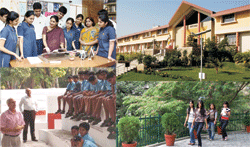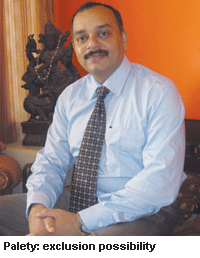For the EW Most Respected Schools Survey 2008, perceptions of a new 2,026 SECA respondents base spread across 15 cities relating to India’s 250 most high-profile schools were solicited. Dilip Thakore reports
 The first league tables of India’s most respected primary-cum-secondary schools published by EducationWorld last year (August 2007) elicited much comment and provoked considerable controversy. The heads and students of some of the country’s most reputed schools such as the Shri Ram School, Delhi; Bombay Scottish and Cathedral & John Connon, Mumbai; Woodstock, Mussorie; Mallya Aditi, Bangalore; Mayo College, Ajmer; Rishi Valley, Chittoor and Welham’s Girls, Dehradun, among others, were understandably outraged by the conspicuous omission of their schools in the league tables. Quite evidently the research and ranking methodology needed reappraisal and revision.
The first league tables of India’s most respected primary-cum-secondary schools published by EducationWorld last year (August 2007) elicited much comment and provoked considerable controversy. The heads and students of some of the country’s most reputed schools such as the Shri Ram School, Delhi; Bombay Scottish and Cathedral & John Connon, Mumbai; Woodstock, Mussorie; Mallya Aditi, Bangalore; Mayo College, Ajmer; Rishi Valley, Chittoor and Welham’s Girls, Dehradun, among others, were understandably outraged by the conspicuous omission of their schools in the league tables. Quite evidently the research and ranking methodology needed reappraisal and revision.
With the benefit of hindsight, it is now clear that although last year’s sample of 908 carefully chosen respondents countrywide (apart from being perhaps small), was classified as SEC (socio-economic category) A/B, in fact, the respondents base was too heavily skewed by field researchers of the polling agency — IMRB International — in favour of respondents in SECB (lower middle class). This hypothesis is supported by the modest household income averaging Rs.16,255 per month of the respondents polled last year — too low to be reflective of the middle-middle and upward classes who constitute the core readership of EducationWorld.
Therefore for the India’s Most Respected Schools Survey 2008 conducted for this publication by the Delhi-based market research and opinion polls agency C fore (Centre for forecasting and research) — which specialises in appraisal of educational and other institutions at the national level, and has been rating and ranking professional education institutes, including B-schools for the past nine years — these pitfalls have been avoided with C fore advising a 15-city perceptual polling exercise restricted to SECA respondents.
 "The distinguishing characteristic of the SECA respondents is that they are an uncompromisingly middle-middle, upper middle class sample group. Thus 90 percent of the new respondents’ base is made up of graduates and postgraduates with the chief wage earner of the household employed at middle or above managerial level as corporate manager or professional with the remaining 10 percent being entrepreneurs employing at least ten employees. This is a relatively high income sample group — Rs.30,000 per month household income — which tends to define education more broadly as a holistic experience, beyond mere academic achievement. Moreover parents who constitute 60 percent of the new respondents base are prepared to pay relatively high tuition fees to buy their children holistic, value-added education. This differentiated respondents’ base explains the sharp contrast in the league tables of 2007 and of this year,” says Premchand Palety, the knowledgeable chief executive of C fore. A graduate of the Punjab Engineering College, Chandigarh, with an MBA and 15 years experience in market research, Palety promoted C fore in 2000. Currently C fore has a clients list which includes Hindustan Times, Times of India, Mint, Outlook, Reliance Telecom, Airtel and the Indian Oil Corporation, among others.
"The distinguishing characteristic of the SECA respondents is that they are an uncompromisingly middle-middle, upper middle class sample group. Thus 90 percent of the new respondents’ base is made up of graduates and postgraduates with the chief wage earner of the household employed at middle or above managerial level as corporate manager or professional with the remaining 10 percent being entrepreneurs employing at least ten employees. This is a relatively high income sample group — Rs.30,000 per month household income — which tends to define education more broadly as a holistic experience, beyond mere academic achievement. Moreover parents who constitute 60 percent of the new respondents base are prepared to pay relatively high tuition fees to buy their children holistic, value-added education. This differentiated respondents’ base explains the sharp contrast in the league tables of 2007 and of this year,” says Premchand Palety, the knowledgeable chief executive of C fore. A graduate of the Punjab Engineering College, Chandigarh, with an MBA and 15 years experience in market research, Palety promoted C fore in 2000. Currently C fore has a clients list which includes Hindustan Times, Times of India, Mint, Outlook, Reliance Telecom, Airtel and the Indian Oil Corporation, among others.
The brief given to C fore by EducationWorld (together with a list of India’s 250 most high-profile schools) was to poll a mix of about 2000 SECA parents, principals, teachers and knowledgeable educationists in 15 cities across India, including the four metros (Mumbai, Delhi, Chennai and Kolkata), almost-metro cities (Bangalore, Hyderabad, Pune, Baroda, Ahmedabad, Chandigarh, Lucknow, Bhopal and Jamshedpur), and respondents in education hubs with a high concentration of scholastic institutions (Darjeeling and Dehradun), on the presumption that the latter would be especially aware about the relative merits inter se of the country’s most well-known schools. “Every respondent was asked to evaluate schools in his/her own region (north, south, west and east) on the assumption that they would be more knowledgeable about proximate schools, on a ten-point scale across 12 parameters. The points awarded under 11 parameters were multiplied by ten — and faculty competence/teacher quality by 20 — and totalled to arrive at an aggregate score for each institution. Schools rated by less than 25 respondents were eliminated from the rankings,” says Palety.
To maintain consistency with last year’s survey, the evaluation parameters — academic reputation, co-curricular education, sports education, competence of faculty, individual attention to students (teacher-pupil ratio), value for money, leadership/management quality, parental involvement, infrastructure provision, quality of alumni, integrity/honesty reputation and selectivity in admissions — remain unchanged. Except that, on the justifiable assumption that a school is as good as its teachers, this evaluation parameter (competence of faculty) has been given prime importance with institutions rated on a scale of 200 points.
Consequently institutions rated and ranked in the EducationWorld Schools Survey 2008 have been evaluated on a maximum scale of 1,300 points. Against this, the top-ranked day school in the country (The Shri Ram School, Delhi) aggregated 1,082; the top-ranked residential school (Doon, Dehradun) aggregated 1,094 and the top international school (Woodstock, Mussoorie) aggregated 1,060. Significantly all the schools topping their classifications (day, residential and international) topped the faculty competence parameter rankings without necessarily topping the academic reputation parameter, implying that the new SECA respondents base believes that there’s more to school education than pursuit of academic excellence.
Although we were tempted to collate a Top 10 list of schools across all categories/classifications, the editors of EW voted against the proposal on the ground that doing so would be tantamount to comparing apples with oranges as the institutional priorities of day, boarding and international schools vary substantially. For instance in boarding/residential schools pastoral care, leadership/management and sports education are more important factors than in day schools. Likewise in international schools, a broad outward looking culture and transnational infrastructure benchmarking are vital considerations and given due diligence. Nevertheless according to C fore managers, cross-category comparisons are not “entirely invalid as all schools have been evaluated on identical parameters”. But in the EducationWorld Schools Survey 2008, we have desisted from making cross-category rankings, leaving such exercises to principals, parents and educationists at their discretion, with the caveat that direct comparisons based on aggregate scores can be misleading.
In the pages following, evaluation data and national, regional and parametral rating and rankings of the EducationWorld Schools Survey 2008 are detailed and highlighted.